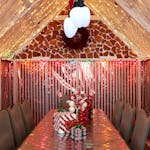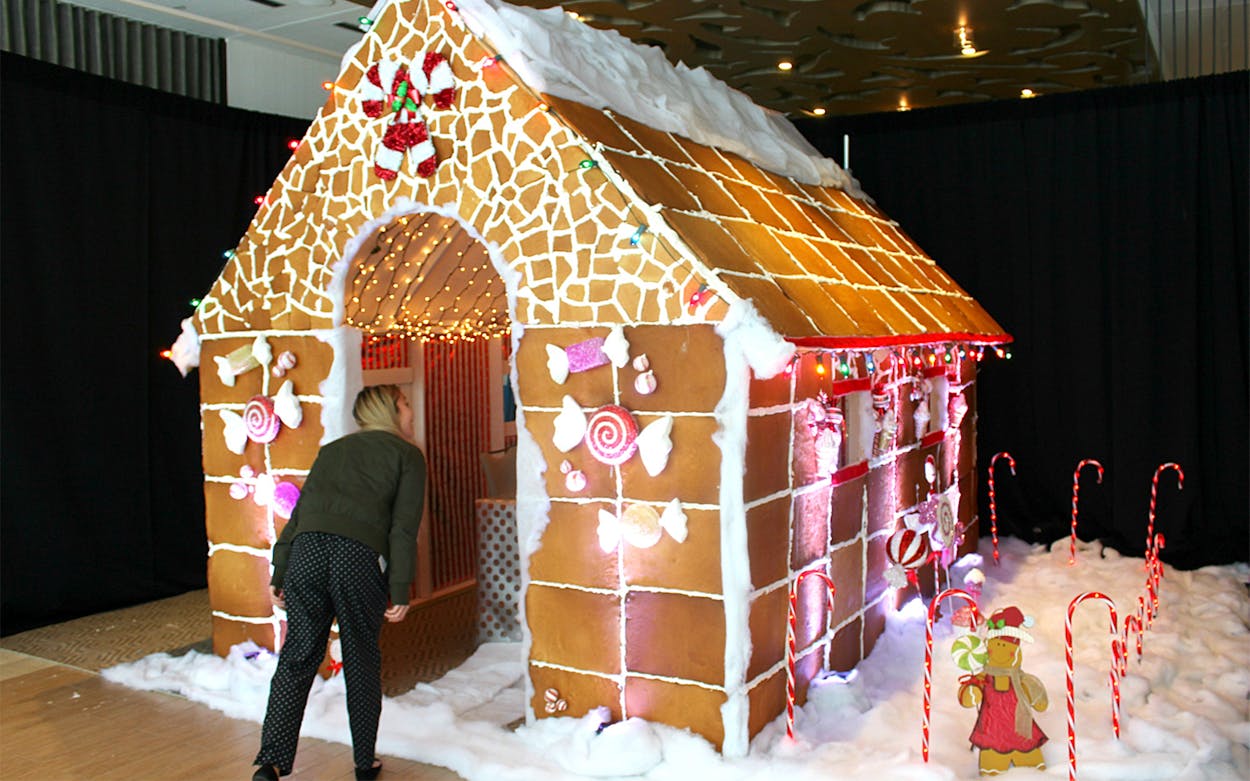Plenty of restaurants celebrate the holidays with a gingerbread house centerpiece. But this year, Stella San Jac, the restaurant at the Westin Austin Downtown, decided to think bigger. A lot bigger, actually—twelve feet by ten feet, with a roomy fifteen-foot ceiling, to be exact.
“We were in a marketing meeting, just brainstorming about Christmas, and we thought, why don’t we make the gingerbread house life-sized?” says Christopher Costs, the Westin’s assistant general manager, who helped orchestrate the project. “The engineering department said, we can do this.” It took four hundred bricks of gingerbread, twenty gallons of icing, and a week of construction, but the team had the edible house they’d dreamed of. After some quick interior decorating—red-and-white wrapping paper for the walls, a table that seats eight—the gingerbread dining room was open for business.
The project required expertise from departments across the hotel, from chefs to a front office manager who knows woodworking. For the engineering team, which usually addresses plumbing and lighting issues, designing an edible home that wouldn’t collapse was an unusual task. “They brought blueprints to us, and had it mapped out as ten feet by eight feet,” says Costs. “But we needed bigger, it being the nature of Christmas.”
With the blueprint finished in early December, it was time for the kitchen to get to work. “Oh, I went along with it,” says chef Martin Wilda. “We have crazy ideas sometimes.” On December 5, Wilda brought in four construction workers—er, sous chefs—to help out, and pulled out all his baking sheets. Using 100 pounds of brown sugar, 300 pounds of flour, 5 cases of butter, 200 pounds of brown sugar, and 6 pounds of ground ginger, the kitchen turned into a factory, churning out hundreds of gingerbread bricks and 20 gallons of icing over the next few days. Wilda’s secret for a gingerbread both tasty and sturdy enough for home-building? Lots of sugar. “We used around 100 gallons of corn syrup—it hardens pretty well,” he says.
While the chefs worked away in their gingerbread kiln, other employees at the Westin, including Costs, started laying the fourteen-pound bricks. The first-time builders faced a steep learning curve. “We got three-quarters of the house done in the first day, but the second day it had fallen apart on us,” says Costs. Turns out, they were using the wrong kind of glue. After a few days—and quite a few broken bricks—the team had figured out how to make it stick, and even found a few workarounds for the construction crew.
“The fake snow on the roof saved us another 30 bricks of gingerbread on the most steep part of the roof,” says Costs. “And up on the two points at either end of the house where the roof goes up, we used breaking pieces of gingerbread to do a mosaic.”

After placing the last brick, construction was done—except for some upkeep that may be unfamiliar to more conventional homeowners. “We’ve seen people try to take pieces of the gingerbread off, and seen kids lick some of the bricks,” says Costs. “If I could afford a security guard for it, I would.” Turns out, it’s tough to find a good home insurance policy for an edible dining room.
Until the team dismantles the gingerbread house on December 28, the home is open to the public for lunch and dinner reservations, with 10 percent of proceeds going to nonprofit Back on My Feet Austin. And Costs expects the special venue will open again for the holidays in 2018. “I don’t think we can not do it again next year,” he says. “It was a great way to bring the property to work together.”
With a whole year to plan ahead, Wilda is already considering gingerbread home improvements. “We’re thinking about putting a second story in,” he jokes. Maybe next year, guests will descend to dinner on a licorice spiral staircase. At the very least, maybe they’ll stop licking the dining room walls.






